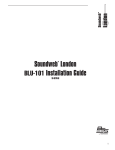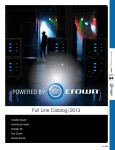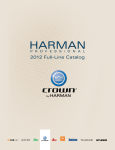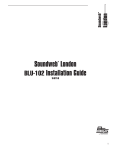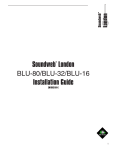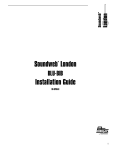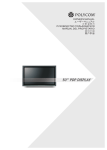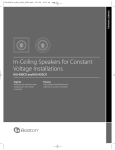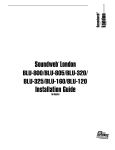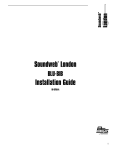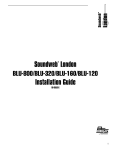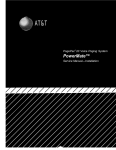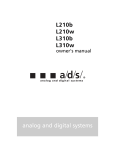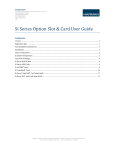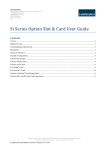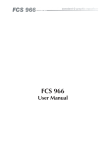Download Crown POWER-TECH 3 Owner`s manual
Transcript
English oWner’s manual OWNER’S MANUAL taBle of contents Introduction........................................................................................................................ 1 Unpacking .......................................................................................................................... 2 Amplifier and Processing Requirements ...................................................................... 4 Speaker Placement .......................................................................................................... 5 Speaker Connections ......................................................................................................10 Specifications .................................................................................................................. 11 Care and Maintenance .................................................................................................. 12 Warranty Information ..................................................................................................... 12 English Introduction Thank you for purchasing the JBL M2 Master Reference Monitor. The M2 is a free-standing, twoway system that can be placed in any environment to provide an exceptionally accurate monitoring experience. Based on a new generation of JBL high-output, ultra-low distortion transducers, the M2 provides extended frequency response, and very high sound pressure level to meet demanding music, cinema and broadcast production requirements. The M2 integrates three key components that work in harmony to deliver unparalleled performance: JBL’s patented D2 dual-diaphragm dual voice-coil high-frequency compression driver uses a revolutionary design to produce smooth, extended high frequency response with ultra-low distortion whether listening at very high or subtle levels. The 2216Nd Differential Drive® lowfrequency transducer uses patented technology to offer deep bass extension and very low power compression, even at its full rated output. In spite of the M2’s compact footprint, the 2216Nd’s exceptional low frequency response eliminates the need for a subwoofer. These unique components make possible a twoway design that provides an unprecedented level of performance. The single seamless crossover point reduces system complexity and allows a compact formfactor for flexibility of placement in the room. The M2 is designed to be used along with Crown® I-Tech Power Amplifiers, which have internal BSS® OMNIDRIVE HD™ Digital Signal Processing that is required to provide The unique Image Control waveguide was developed specifically for the M2. Allowing an acoustically seamless transition between the low-frequency and high-frequency transducers, this waveguide delivers remarkable imaging and natural balance at nearly any listening position in a broad range of acoustic environments. the electronic crossover functions and room tuning EQ for each speaker. The room EQ allows you to optimize the M2’s performance in any room by minimizing the negative effect of room modes (standing waves). The M2 brings a world-class, big monitoring experience with a new level of accuracy and detail to a broad range of production spaces. 1 Unpacking 1. Open the shipping carton and rotate so it is upright with the end labeled “This Side Up” at the top. 2. Slide the speaker out of the carton with the packing end-pads attached. 3. Remove the spikes from the top packing end-pad and remove the end-pad from the speaker. IMPORTANT: The M2 in the shipping carton weighs 150 lbs. To avoid injury to yourself or damage to the speaker, two people are required to unpack and move the speaker. 4. Remove the protective wrapping from the speaker. 5. Lift the speaker out of the bottom end-pad. It is ok to use the port openings as handles. Be careful not to damage the grille or woofer cone. We recommend you retain the carton and packing materials for future use. Please Register Your Speakers Take a moment to register your speakers on the JBL Professional Web site. Go to www.jblpro.com/M2 and click “Register Your M2”. Registering your M2 will allow you to receive important updates and information about your speakers. 1. 2. “This Side UP” 2 3. Packing End Pad 2 Remove Spikes 4. 5. English Installing the Spikes The M2 is shipped with four rubber feet attached to the bottom of the enclosure for use when the speaker is installed upright on a hard surface. Four pointed spikes are included that allow the speaker to acoustically decouple from the floor when it is installed upright on a carpeted floor. WARNING: The spikes are extremely sharp. Use caution when handling them. If you wish to use the spikes when installing the speaker on a hard surface, place coins or similar items under the spikes to prevent damage the floor surface. When moving the speaker with the spikes attached, never slide it along the floor, as this can damage the floor, the spikes or the speaker itself. Lift the speaker and carry it to its new location. When using the spikes, do not remove the rubber feet from the speaker. To install the spikes, position the speaker on a carpeted or padded surface. Insert the threaded end of the spike into the aperture of the rubber foot. Turn the spike in a clockwise direction and continue until the spike is inserted as far as it will go. 3 Amplifier and processor Requirements The M2 contains no internal crossover network; it must be used with BSS Omnidrive HD Digital Signature processing to provide proper integration of the speaker’s low-frequency and high-frequency transducers. The following Crown power amplifiers incorporate BSS Omnidrive HD DSP and are specified for use in the M2 System:: • Crown I-Tech 5000HD two-channel amplifier (one amplifier is required for each M2 speaker) IMPORTANT NOTE: Crown I-Tech power amplifiers are equipped with cooling fans that run continually whenever the amplifier is powered on. To minimize environmental noise, we recommend you locate these amplifiers in a well-ventilated area outside of the listening room. • Crown I-Tech 4x3500HD four-channel amplifier (one amplifier is required for two M2 speakers) If you wish to use an amplifier other than the two Crown I-Tech models specified above, you must also use the BSS Soundweb™ London BLU-800, BLU-160 or BLU-80 signal processor to provide the Omnidrive HD processing required by the M2. (A list of recommended M2 system components can be found in the downloads section at www.jblpro.com/M2.) To load the M2 DSP preset parameters into a Crown I-Tech amplifier: To load the M2 DSP parameters into a BSS Soundweb processor: 1.Using your computer download the JBL M2 Crown I-Tech DSP preset file located in the downloads section at www.jblpro.com/M2. Loading preset DSP parameters into a BSS Soundweb processor requires that you: 2. Transfer the file to the root directory of a USB thumb drive and insert the drive into the amplifier’s front-panel USB port. 3. Text in the amplifier display asks whether you want to load a device file or preset file. Depress the right Encoder (large knob/button) to select “preset”. 4. The amplifier screen displays “Select File to Load.” Rotate the right Encoder to select the M2 preset file in the USB drive’s root directory. (Note: You can’t explore folders or subfolders in the USB drive’s directory.) 5. Depress the right Encoder to load the file. The amplifier will load the file into its memory and the display will show the Eject Menu. 6. Depress the left Encoder when the transfer is complete. 4 • Establish a wired Ethernet connection between your computer and the BSS Soundweb processor. (This requires that your Ethernet network has a network switch or router. You cannot make a direct Ethernet connection between the computer and processor.) • Download HARMAN HiQnet London Architect Software from the BSS website at www.bssaudio. com and install it on the networked computer (using a computer with Windows XP or Windows 7 operating system). • Download the JBL M2 BSS BLU DSP preset parameters to your computer from http://www.jblpro.com/M2. Refer to the operating instructions for the BSS Soundweb processor and the London Architect software for complete information about programming the processor. English Speaker Placement The compact width and depth dimensions of the M2 allow flexibility of placement in a range of production spaces, whether free standing, positioned adjacent to a wall, or in a corner. Digital signal processing in the M2 system’s Crown amplifier or BSS Soundweb London processor provides room-tuning capability that can reduce the negative effect of room modes (standing waves) and compensate for deviations in response created by the speaker’s proximity to the room’s boundaries. This provides exceptional placement flexibility, even when M2s are installed in relatively small control rooms or project studios. Please observe these guidelines when placing M2 speakers in the workspace: • Do not place the M2 near a heat register or a source of open flame (such as a fireplace). • Do not expose the M2 to moisture, dripping or humid environments. • Take precautions to ensure that animals do not enter the speakers’ port openings. • To protect the woofer cone from potential damage, always use the speaker with the supplied grille attached. For optimum performance please review and observe the following guidelines: Horizontal Coverage Window To achieve optimum performance at the listening position the listener should be seated within ±30° of the waveguide’s horizontal centerline (see illustration to the left). If necessary, the M2 speaker should be angled towards the listener to keep the listener within the coverage window. 5 Freestanding Placement In two-channel installations, the distance between the right and left speakers is determined by the distance from the listening position to the speakers – the further away the listener is from the speakers, the further apart the speakers can be placed. The unique geometry of the M2’s Image Control waveguide enables the speakers to deliver accurate high frequency detail, imaging, and natural balance at nearly every listening position in a typical listening environment. To obtain the best stereo effect in a two-channel installation, each speaker should be placed an equal distance from the listening position. Placing the speakers relatively far apart from each other can weaken the “phantom image” of sounds intended to be heard in the center of the stereo soundstage, such as vocals. In such an installation, increasing the inward angle (toe-in) of the speakers toward the listener will improve the strength of the “phantom center” image. Mo Toe Less Toe-In 60° – 40° – 60° More Toe-In 60° – 90° The M2 is designed so that when placed directly on the floor, the ears of a seated listener will be in the center of the speaker’s vertical coverage window, eliminating the need to elevate the speaker. 6 English Placement behind a mixing console When installing M2 speakers behind a mixing console, the speakers should be elevated so the console does not impede speaker performance. Ideally, a line drawn from the center of the woofer perpendicular to the M2 enclosure should clear the top of the console meter bridge. The illustration below shows M2 installation behind a professional mixing console. When placed behind a console with a meter-bridge height of 45”, the M2 speaker should be elevated 20” off the floor. 92 inches Woofer Centerline 25” 45” 20” In this illustration, the M2 is elevated 20 inches and the recommended distance between the speaker and a seated listener is 92 inches or greater. When a speaker is elevated, the distance of the high frequency driver to the listener may be greater than the distance of the low frequency driver to the listener. Observing the recommended minimum listening distance optimizes loudspeaker coverage at the listening position. Additional technical information is available in the Downloads section at www.jbppro.com/M2 Recommended Minimum Listening Distance of Speakers* This table provides minimum listening distance recommendations for a seated listener when the speaker is elevated. As an example, when the speaker is elevated 20 inches above the floor, a seated listener should be 92 inches or greater from the speaker. Speaker Elevation (inches): Minimum Recommended Listening Distance (inches): 16 46 18 69 20 92 22 115 24 138 26 161 28 184 30 206 * Assumes listener ears are 42” from the floor CAUTION: Unsafe speaker placement can cause personal injury or damage to the speaker. - Ensure each M2 is placed on a stable platform that is capable of bearing the full weight of the speaker. - Ensure that the front and sides of the speaker enclosure are perpendicular to the platform. - If the speaker is to be used at an elevated height or used at an angle other than perpendicular to the supporting platform, the speaker should be professionally installed and restrained to ensure it will not fall. - The M2 enclosure is not designed to be suspended. - Never drill holes into the M2 enclosure. 7 Horizontal Placement The M2 speakers can be used in a horizontal orientation. When used horizontally, each M2 should be elevated so the JBL logo is at ear height. Toe-in may be required to provide optimum coverage. The closer the listeners are to the speakers, the more toe-in will be required. (See example below.) Orienting the speakers with waveguides towards the inside and woofers outside may be preferable in installations where the listeners are unusually close to the speakers. The speaker’s rubber feet may be removed when mounting the M2 in a soffit. Horizontal Placement 8 The M2 is designed for use in cinema applications with perforated projection screens. The wide directivity and relatively shallow depth of the M2 waveguide permit a range of speakerto-screen distances with little variation in performance. Digital equalizers in Crown power amplifiers and BSS Soundweb London processors used in English Use with perforated projection screens the M2 System compensate for screen loss, and restore neutral frequency response in the listening space. Additionally specialized equalization curves can be applied such as the X curve. EQ and tuning recommendations can be found in the Downloads Section at www.jblpro.com/M2. 9 Connections CAUTION: Power off amplifiers when making connections. Making connections while an amplifier is operating can damage the speaker system and void the warranty. Amplifiers should also be powered off before connecting or disconnecting any components in the signal chain. The M2 connector panel has two sets of pushterminals. The upper set of terminals is for the highfrequency transducer and the lower set of terminals is for the low-frequency transducer. Connect the speaker to the high-frequency and low-frequency channels of your power amplifier as shown in the example below. M2 Connector Panel Crown I-Tech 5000HD Power Amplifier High-Frequency Output Low-Frequency Output The M2 speaker terminals are designed to accept bare wire. Push down on the top of the terminal to open the connection hole, insert the bare wire and release the terminal to secure the wire. IMPORTANT: Make sure that the (+) and (–) bare wires do not come in contact or contact the adjacent terminal. Wires in contact with each other can cause a shortcircuit that can damage the power amplifier. High-Frequency Connectors Low-Frequency Connectors The M2’s (+) speaker terminals are red; the (–) terminals are black. Always connect the conductors of the speaker wire appropriately to the corresponding negative and positive terminals on all speaker and amplifier terminals: amplifier “+” to speaker “+”; amplifier “–” to speaker “–”. This will ensure all components work together in proper polarity (sometimes referred to as “in phase”). Connecting the speakers with improper polarity (sometimes referred to as “out of phase”) can result in reduced low-frequency output, impaired stereo effect. and inferior performance in the crossover region. NOTE: The M2 is designed so that a positive voltage appearing at both (+) input terminals will cause the low-frequency diaphragm to move towards the listener and will cause the high-frequency diaphragm to move away from the listener. This is necessary to maintain proper phase between the transducer outputs in the crossover region. 10 English Specifications System format: Two-way floor-standing or soffit mountable High-frequency transducer: D2430K dual-diaphragm dual voice-coil compression driver Nominal impedance: 20 ohms Low-frequency transducer: 2216Nd 15” (381mm) Differential Drive® cone driver Nominal impedance: 6 ohms Crossover frequency: 800Hz (supplied by outboard Digital Signal processing) Frequency range: 20Hz – 40kHz Image Control waveguide dispersion: 120° H x 100° V Sensitivity (1W/1m): 92dB SPL Continuous/peak SPL@ 1m:117dB/129dB System requirements: One Crown I-Tech 5000HD amplifier per speaker or one Crown I-Tech 4X3500HD amplifier per two speakers or BSS Soundweb London BLU-800, BLU-160 or BLU-80 processor with a Crown Macro-Tech® 5000i or other suitable amplifier Recommended amplifier power: 1200 Watts per channel into 8 ohms Input connectors: Individual spring terminals for low-frequency and high-frequency Enclosure construction: 25mm (1”) MDF Finish: Satin black lacquer Included: Removable ABS grille with black UL-compliant fabric; 4 steel floor spikes Dimensions (W x H x D): 508mm x 1256mm x 356mm (20” x 49-1/2” x 14”) Weight: 58.5kg (129 lb) 11 Care and Maintenance The JBL M2 Master Reference Monitor requires no regular maintenance other than occasional dusting with a soft, dry, lint-free cotton cloth. The waveguide may also be wiped with a soft cloth. Treat the lacquered enclosure surfaces carefully to avoid scratching the finish. To remove fingerprints and smudges, apply a small amount of diluted ammonia-free or alcohol-free detergent to the cloth and gently clean the surface. • Never use any abrasive cleaners or chemicals to clean the enclosure. If the enclosure becomes noticeably scratched or otherwise damaged, consult a qualified furniture repair shop. • To protect the woofer cone from physical damage, always use the speaker with the supplied grille attached. Warranty Information The JBL Limited Warranty on professional loudspeaker products (except for enclosures) remains in effect for five years from the date of the first consumer purchase. Enclosures and all other JBL products are warranted for two years from the date of original purchase. 12 Who Is Protected By This Warranty? What Does The JBL Warranty Cover? Who Pays For What? Your JBL Warranty protects the original owner and all subsequent owners so long as: A.) Your JBL product has been purchased in the Continental United States, Hawaii or Alaska. (This Warranty does not apply to JBL products purchased elsewhere except for purchases by military outlets. Other purchasers should contact the local JBL distributor for warranty information.); and B.) The original dated bill of sale is presented whenever warranty service is required. Except as specified below, your JBL Warranty covers all defects in material and workmanship. The following are not covered: Damage caused by accident, misuse, abuse, product modification or neglect; damage occurring during shipment; damage resulting from failure to follow instructions contained in your Instruction Manual; damage resulting from the performance of repairs by someone not authorized by JBL; claims based upon any misrepresentations by the seller; any JBL product on which the serial number has been defaced, modified or removed. JBL will pay all labor and material expenses for all repairs covered by this warranty. Please be sure to save the original shipping cartons because a charge will be made if replacement cartons are requested. Payment of shipping charges is discussed in the next section of this warranty. If your JBL product ever needs service, write or telephone us at JBL Incorporated (Attn: Customer Service Department), 8500 Balboa Boulevard, PO. Box 2200, California 91329 (818/893-8411). We may direct you to an authorized JBL Service Agency or ask you to send your unit to the factory for repair. Either way, you’ll need to present the original bill of sale to establish the date of purchase. Please do not ship your JBL product to the factory English How To Obtain Warranty Performance without prior authorization. If transportation of your JBL product presents any unusual difficulties, please advise us and we may make special arrangements with you. Otherwise, you are responsible for transporting your product for repair or arranging for its transportation and for payment of any initial shipping charges. However, we will pay the return shipping charges if repairs are covered by the warranty. Limitation of Implied Warranties ALL IMPLIED WARRANTIES, INCLUDING WARRANTIES OF MERCHANTABILITY AND FITNESS FOR PARTICULAR PURPOSE, ARE LIMITED IN DURATION TO THE LENGTH OF THIS WARRANTY. EXCLUSION OF CERTAIN DAMAGES JBL’S LIABILITY IS LIMITED TO THE REPAIR OR REPLACEMENT, AT OUR OPTION, OF ANY DEFECTIVE PRODUCT AND SHALL NOT INCLUDE INCIDENTAL OR CONSEQUENTIAL DAMAGES OF ANY KIND. SOME STATES DO NOT ALLOW LIMITATIONS ON HOW LONG AN IMPLIED WARRANTY LASTS AND/OR DO NOT ALLOW THE EXCLUSION OF INCIDENTAL OR CONSEQUENTIAL DAMAGES, SO THE ABOVE LIMITATIONS AND EXCLUSIONS MAY NOT APPLY TO YOU. THIS WARRANTY GIVES YOU SPECIFIC LEGAL RIGHTS, AND YOU MAY ALSO HAVE OTHER RIGHTS, WHICH VARY, FROM STATE TO STATE. 13 www.jblpro.com/M2 HARMAN International Industries, Inc. | 8500 Balboa Bl. | Northridge, CA 91329 USA ©2013 HARMAN International Industries, Incorporated. All Rights Reserved. JBL, Crown, BSS and Differential Drive are trademarks of HARMAN International Industries, Incorporated, registered in the United States and/or other countries. Image Control, Soundweb, Omnidrive HD, HiQnet and System Architect are trademarks of HARMAN International Industries, Incorporated. Part Number: 5030284 – Rev. A 04-21-2013
















